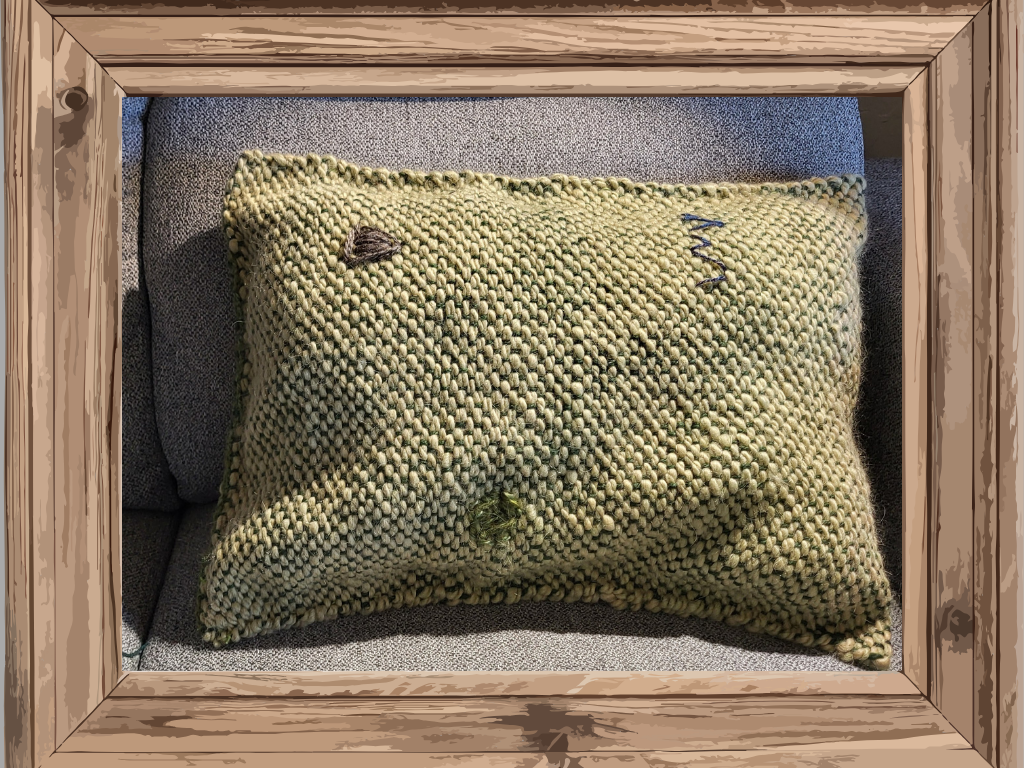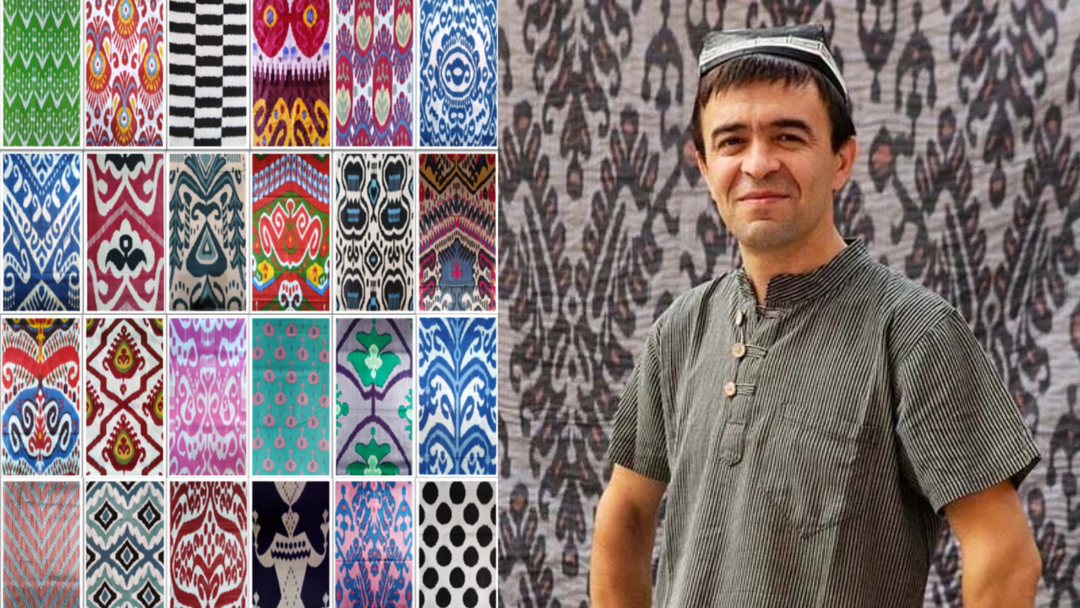(Originally published in digital magazine, HandEye Magazine; updated in June 2023)
Munira is racing against time. She is desperately trying to save the artistic legacy of her little corner of the Silk Road. She is the designer for two small artisan groups in northern Tajikistan that focus on suzani embroidery, quroq patchwork, and ikat weaving. Her greatest fear is that 2500 years of culture rooted in these arts will be lost to the “fast fashion” industry.

Rikki Quintana (Center) and Munira Akilova (Right) in Tajikistan (2022)
I started working with Munira in early 2015. I had just launched HoonArts Fair Trade a couple of months before, because no one else in the US was working with Tajik artists.
By the time Munira and I ended our first Skype chat, it was clear that we had the same dream of making a difference in the world. Munira later told me, “When I got really sick a few years ago, embroidery was the only thing that brought me back to life. That was when I decided that I wanted to devote the rest of my life to embroidery.”
Munira and I agreed right away that we needed to make her designs stand out in a world of cheap, mass-produced products. If we could build a high quality, eco-friendly “sustainable” brand, we knew we could compete in the Western market.
It turns out that it’s not as easy as it seems in this part of the world. Tajikistan is the smallest and poorest of the former Soviet Republics of Central Asia, sometimes referred to as the “Stans.” Although it was a famous Silk Road center for more than a thousand years, most people in the US haven’t even heard of this small country in Central Asia.
There are very few skilled artisans left. When the Soviets started pushing industrialization in the 1930’s, the government actively suppressed the traditional arts. For example, authorities destroyed weaving equipment and sent master weavers to labor camps and mines. A few of these weavers hid their equipment and wove in secret to keep the knowledge alive.
Munira and her boss Jamshed both come from these old artisan families. Munira’s grandparents were weavers who were forced to abandon their weaving. Jamshed’s grandfather was a skilled “abrband,” the person who ties the threads for hand-dyeing to create the colorful “adras” patterns. (Adras is one type of ikat weaving in this part of the world.) He was rewarded with four years in the mines for practicing his art.
Even the stories of government suppression seem to be passed down only within the artisan families. I asked my other key coordinator, who personally knows all the master artisans around the country, about Soviet suppression. He told me, “No, I never heard of such cases.”
The five-year Tajik civil war that followed independence in 1991 only made this situation worse. It killed 20,000 people, forced 600,000 from their homes and wrecked the economy and infrastructure.
Munira Akilova is trying to rescue the old skills and knowledge and pass them on to future generations. She personally spent months searching out the traditional suzani, quroq and weaving patterns in small mountain villages. She talked to the grandmothers and grandfathers who remembered the old skills. She learned the old stories and meanings behind the patterns. Then she helped create the first catalogue of patterns and ornaments of the Zerafshan Valley of northern Tajikistan, published in 2015.


Antique Suzani Wall Hangings
But for long-term survival, Munira needs more than the authentic patterns. To compete successfully in the sustainable fashion market, she needs high quality, eco-friendly natural fibers; natural dyes; and reliable colors that meet Western tastes. Unfortunately, these are all complicated goals in modern Tajikistan.
It's tough to find any good quality fabric in Tajikistan, much less eco-friendly natural fibers. The market is flooded with cheap Chinese synthetic imports. Even though cotton is Tajikistan’s largest crop, getting international organic certification is too expensive. There are a few local textile manufacturers, but their quality usually doesn't meet Western standards.
The few local companies that do produce good quality cotton fabric use colors designed for local tastes. Munira and I often joke that there's no such thing in Tajikistan as too many colors, colors that don't go together, or colors that are too bright and shiny.

One of Munira’s Early Designs Combining Adras & Embroidery
We might be able to have one of the big companies produce a custom color batch for the US market, but only if we ordered 1200 meters of fabric, which we can't afford. And of course, we can't take a large order for finished products if we can't guarantee that the colors are going to match the sample product colors the buyer saw.
The big companies only use chemical dyes, not eco-friendly dyes. And many of the natural dyes that are popular in the West are not available in Tajikistan. I got excited about the possibility of working with indigo, but Munira dashed my hopes when she said, “I would love to work with indigo. But we can't get it. Maybe one of the big companies could import it, but we would have to order 1200 meters of fabric.”
Doing her own dyeing is also a problem. Dyeing skills in the artisan community are limited, because the old knowledge has been lost. Munira and other top artisans from other Tajik handicraft firms went to Kyrgyzstan in 2016 to get basic training in mixing chemical dyes to produce selected colors. I also sent Munira a set of Pantone color guides so that we can at least be sure that we’re talking about the same color at both ends of a Skype call. And Munira sent me a sample card with all the colors of embroidery thread that she works with from her normal supplier–a Russian supplier because of the reliable quality.

Munira’s Team at Armughon Handicrafts at Work
Munira is beginning to experiment with some locally available eco-dyes, but they are not yet at the stage where they can guarantee that the colors can be reliably reproduced. She's also working with one of the old adras weaving masters. But the learning process is slow and the production capacity is very small.

Early work on modern eco-adras.
The Western market loves the bold colors and patterns of the traditional handwoven silk and silk/cotton adras. But that fabric is no longer produced locally in Tajikistan. Today the genuine handwoven silk fabric comes from Uzbekistan. The Uzbek weavers have told me that it's easier to ship ikat fabric to the US than to neighboring Tajikistan, so Munira can't buy direct unless she visits in person. Instead she's limited to what's available in the local wholesale market. That usually means single bolts in the traditional 16-inch width, and it's expensive. That makes anything but custom or one-of-a-kind orders almost impossible.
In 2016, I ordered some new adras kimono-style jackets. Munira and I agreed on several available fabrics, and she set off to buy fabric for two kimonos each. But the vendor refused to sell her enough for two jackets because he would be left with less than the minimum 7-9 meters for the next customer. And she couldn’t afford to buy the whole bolt without an order for finished products.
Using recycled fabric is also not an option. In Tajikistan, recycling means turning family heirlooms, like wall-size suzani tapestries, into cheap tourist souvenirs. When I visited Tajikistan in 2015, I saw Munira close to tears as she watched another artisan about to cut up one of these rare heirlooms for cell phone cases.
Designing for the US market is also a challenge. Many, if not most, successful sustainable fashion and home décor brands that work with global artisans use Western designers. This provides sorely-needed work for local artisans, but it dilutes the authenticity of the designs. And Munira is passionate about saving those local patterns that carry so much of her cultural history.
2023 Update:
Since I wrote the original article above in 2016, we have experienced new challenges and begun to explore new opportunities in our efforts to save the textile traditions of Tajikistan. The journey continues.
We participated in two US trade shows. Munira created a collection of beautiful embroidered home décor products for the first show, and a collection of hand embroidered bags for the second show.
Ultimately, we concluded that production costs and production capacity in Tajikistan were not quite ready for larger scale wholesale in the US market.

Rikki at Las Vegas Market (2019) - Hand Embroidered Bags Collection (Black & White)
We have been able to do some small custom orders for US buyers, including the Boulder Dushanbe Teahouse in Boulder, Colorado and the National Association of Women Business Owners (NAWBO). These include small wall hangings for the 25th Anniversary Celebration of the Teahouse and custom-embroidered clutches for NAWBO. This is a line of work that we continue to explore.

Small Wall Hanging for Boulder Dushanbe Teahouse. - NAWBO Hand Embroidered Clutches
The world has also weathered the global COVID-19 pandemic, which shut down travel, killed millions of people, and decimated health systems and economies around the world. Munira herself experienced 3 bouts of COVID and lost her father to the virus.
I had one order ready to ship that sat in Tajikistan for over 6 months because the international airport in Dushanbe was shuttered for months. Sales inside Tajikistan plummeted because there were no international travelers. HoonArts sales in the US dried to a mere trickle. Many artisan groups in Central Asia lost a number of participating artisans because of the lack of sales.
In the face of the physical shutdown, we went online with the rest of the world. With some extra coaxing, Munira joined HoonArts audiences live from Tajikistan for a variety of online webinars and experiences in which she was able to explain the history, culture, and processes behind her beautiful products in an interactive atmosphere. She has even taught an online suzani embroidery master class, complete with downloadable authentic suzani patterns. These online experiences have been a bit hit with participants and serve as a great way to introduce Western audiences to the textile arts of the Silk Road.

Munira live from Tajikistan via Zoom.
Munira also accompanied the first HoonArts in-person crafts tour to Central Asia in the fall of 2022. (Munira is also a certified Silk Road tour guide!) It makes all the difference to have a practicing master artist as part of the team to share her expertise along the Silk Road journey! We’re busy developing the itinerary for our next tour, planned for May 2023.

Munira lending her artistic expertise during 2022 Tour
We still face many of the same challenges with access to high quality raw materials at reasonable cost that made entering the US market difficult in 2015. There has been modest progress with locally produced handwoven cotton and ikats in the last few years, so we’re able to offer some new products using these fabrics. Costs of raw materials and shipping, of course, have increased since the pandemic.
And the explosion of online commerce has made it more and more difficult to capture the attention of potential buyers in the US. The algorithms and advertising practices of “big tech” have also caused the costs of effective online advertising to skyrocket.
So, we continue our journey with baby-steps--small quantities and one-of-a-kind products. Munira continues her work with eco-dyeing and cotton adras weaving. And she teaches the next generation the old techniques and patterns. Our virtual experience offerings are opening a unique doorway into the Silk Road world of Tajikistan. We just hope that our market breakthrough will happen before these textile arts are lost forever. “Nasib,” as they say in Tajik—a word that means both destiny and hope.







Munira’s story is beautiful and her aspirations so admirable.
Are you in the process of planning another tour that might help her and the weavers?
Leave a comment